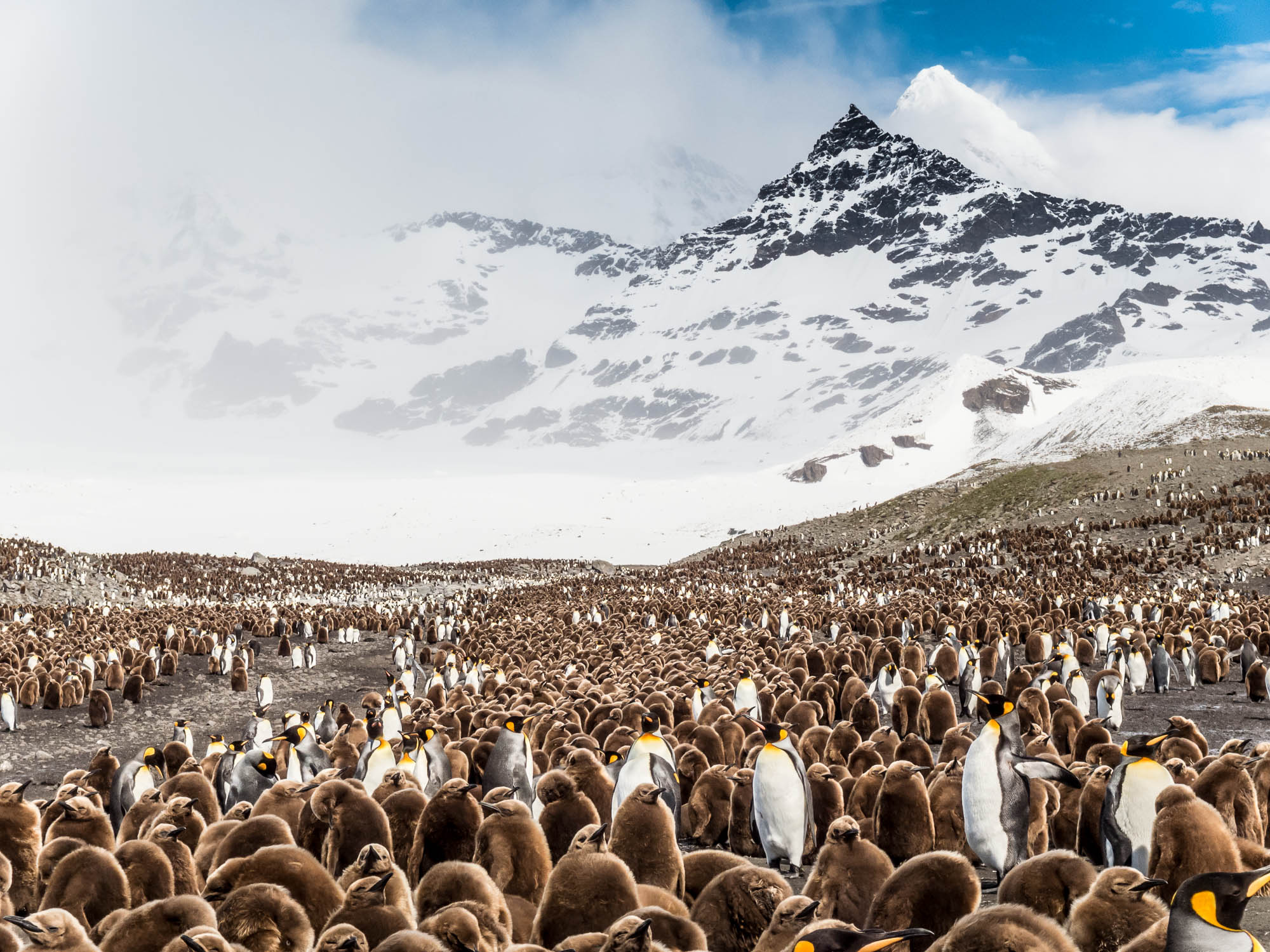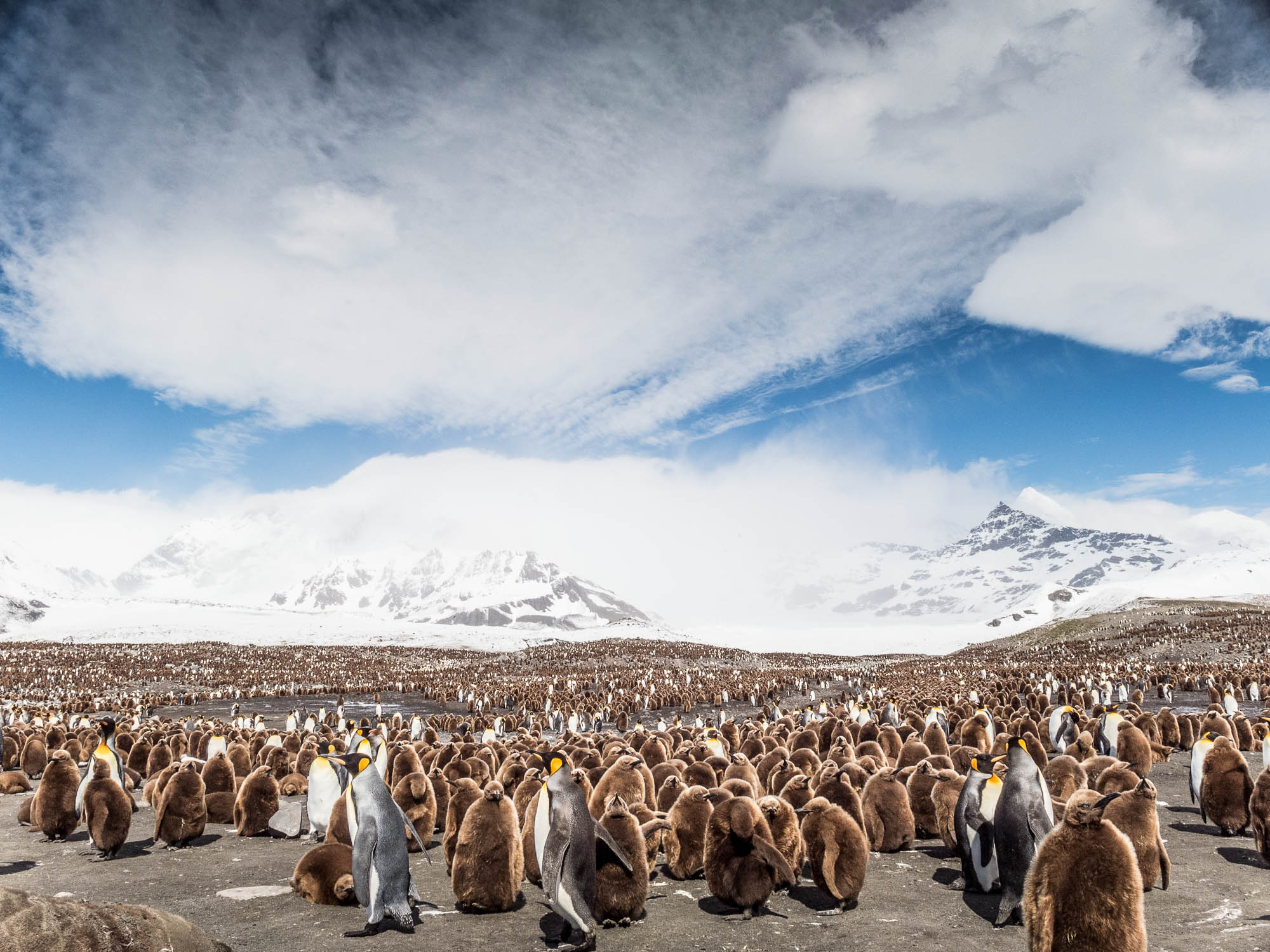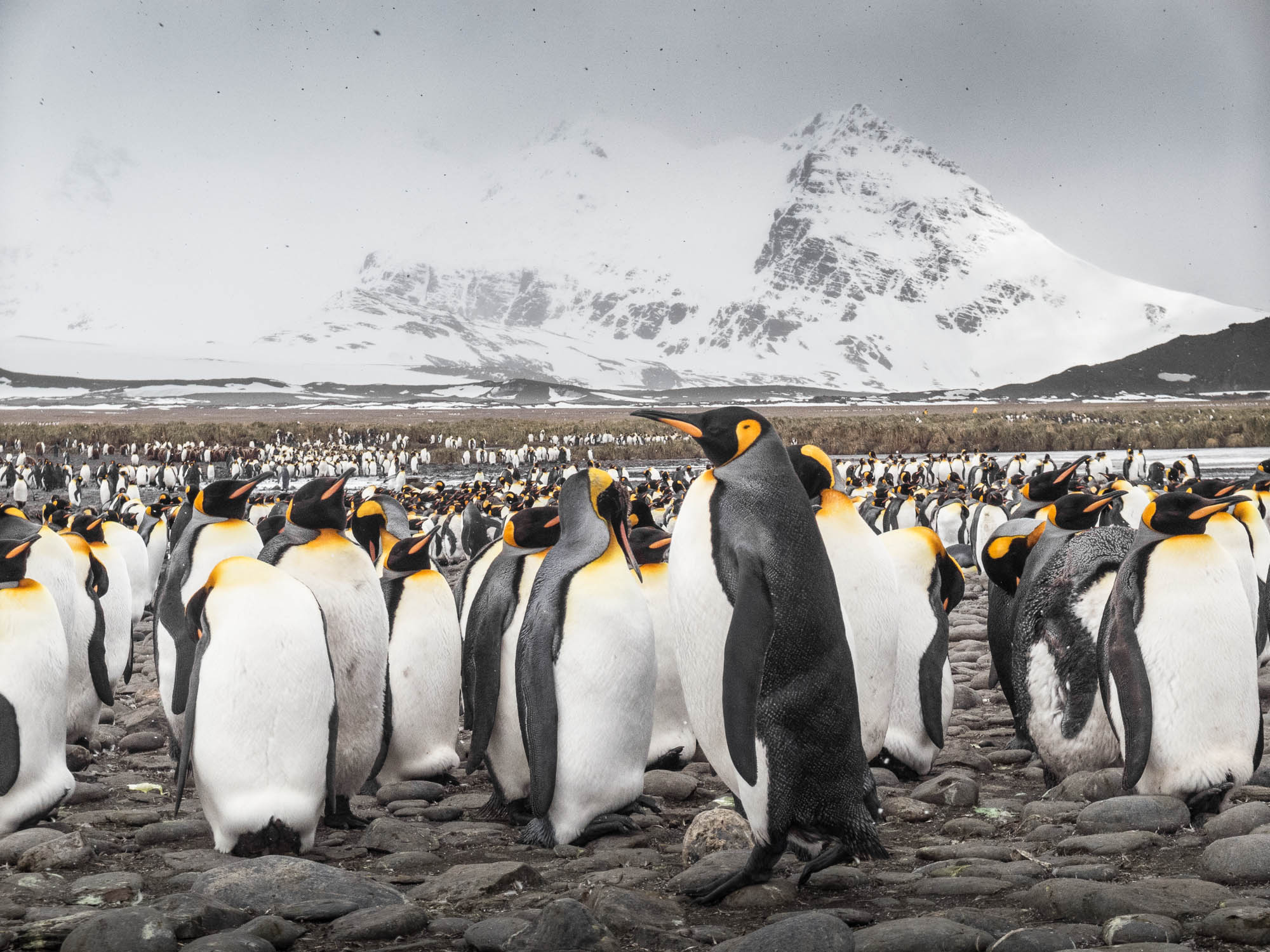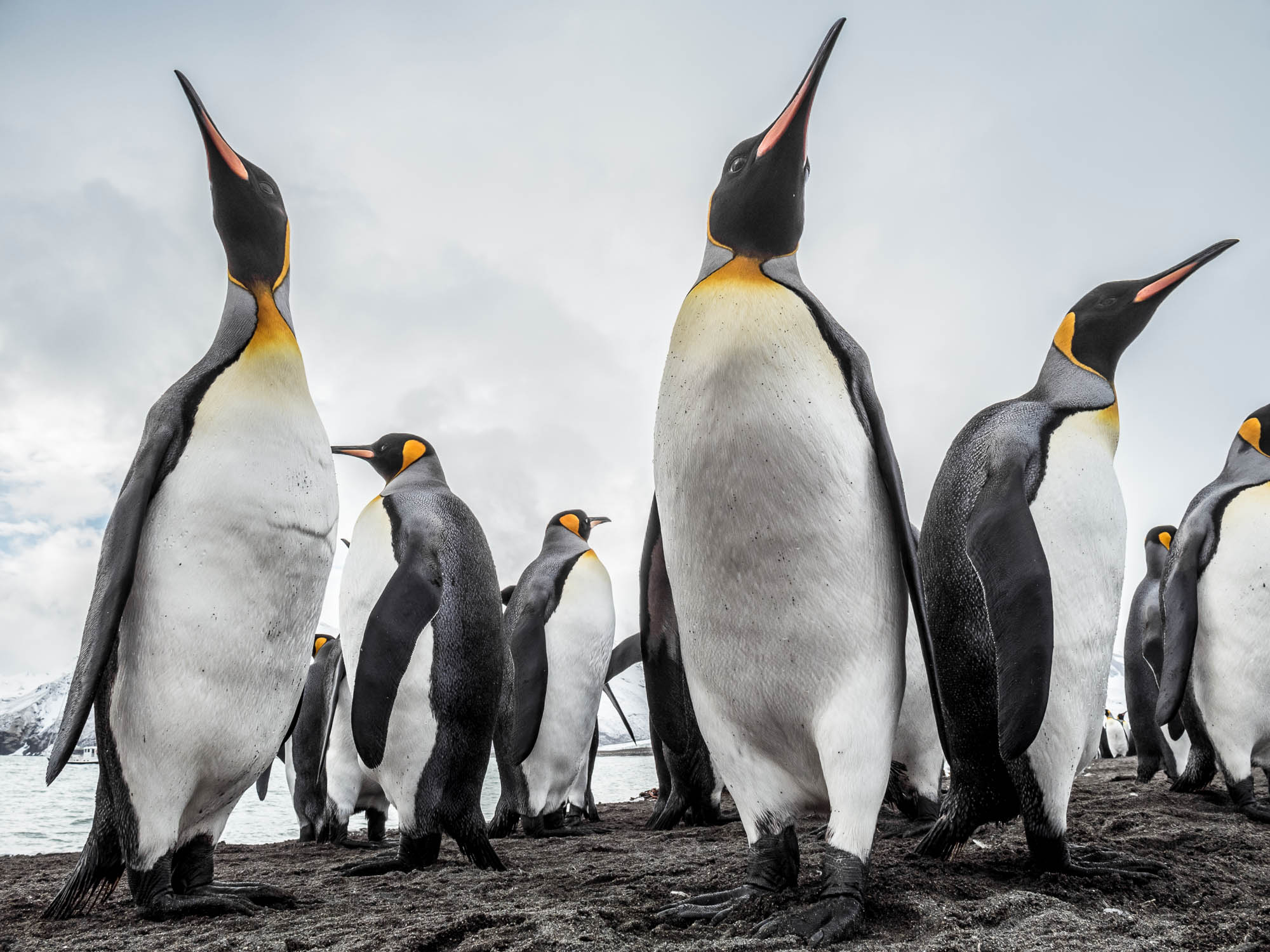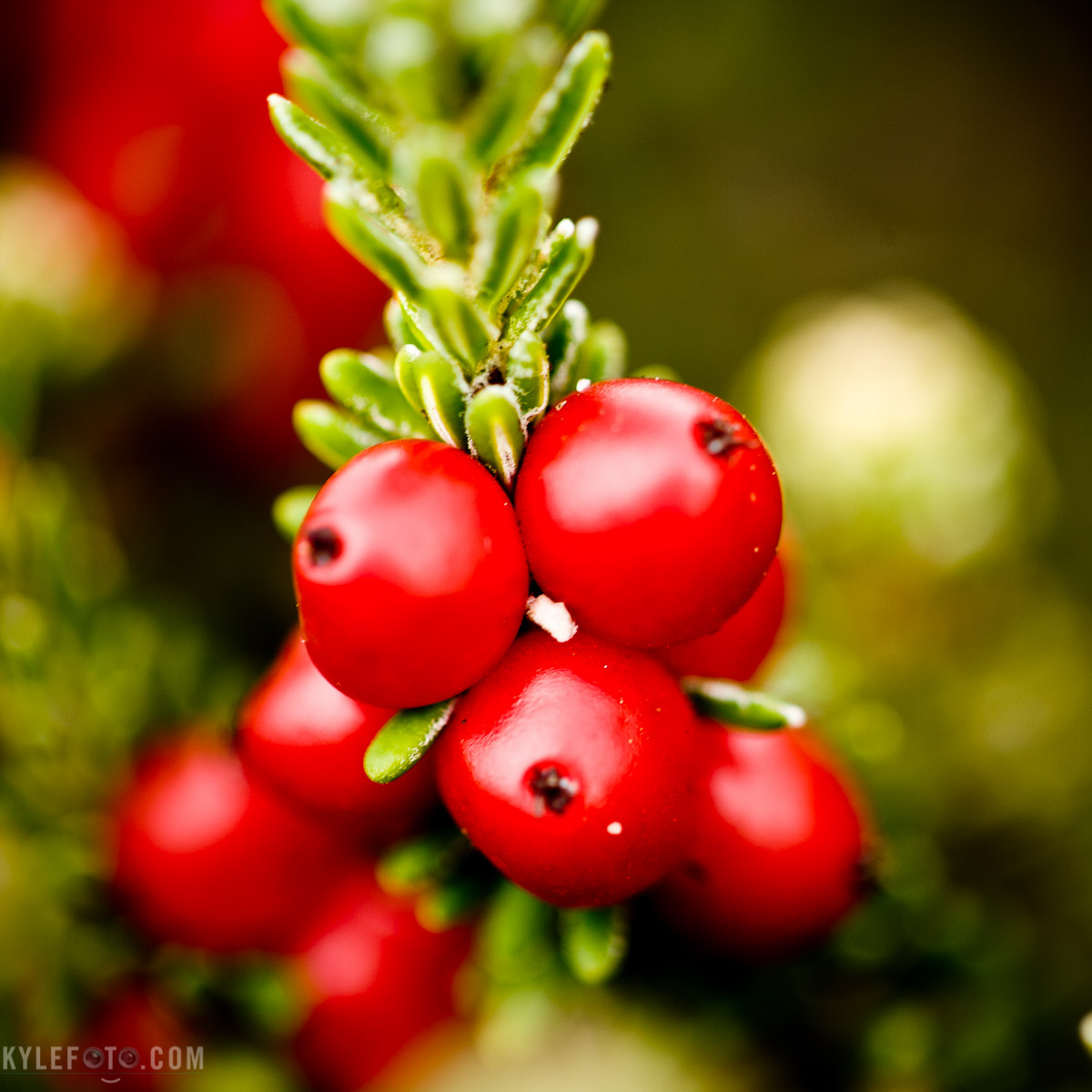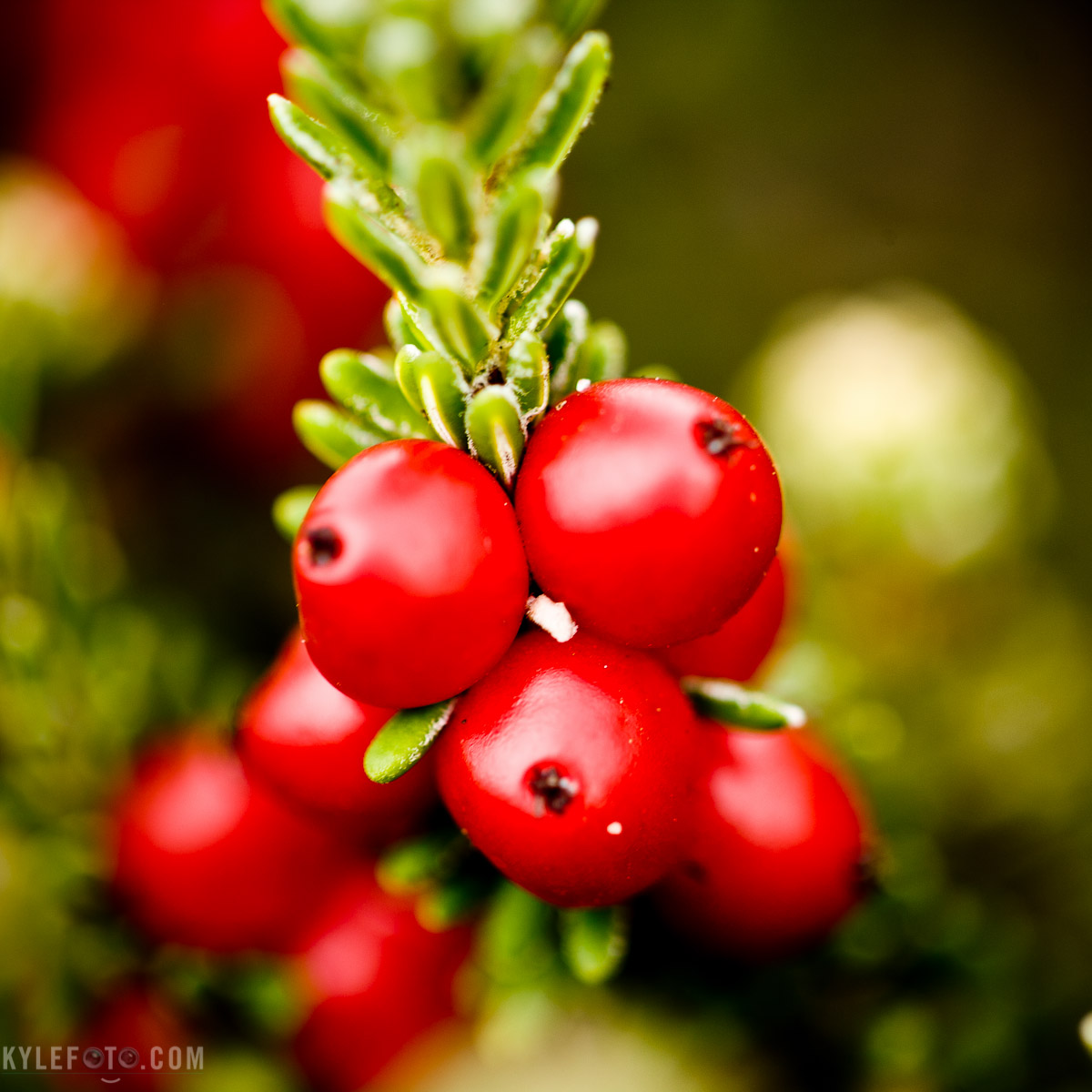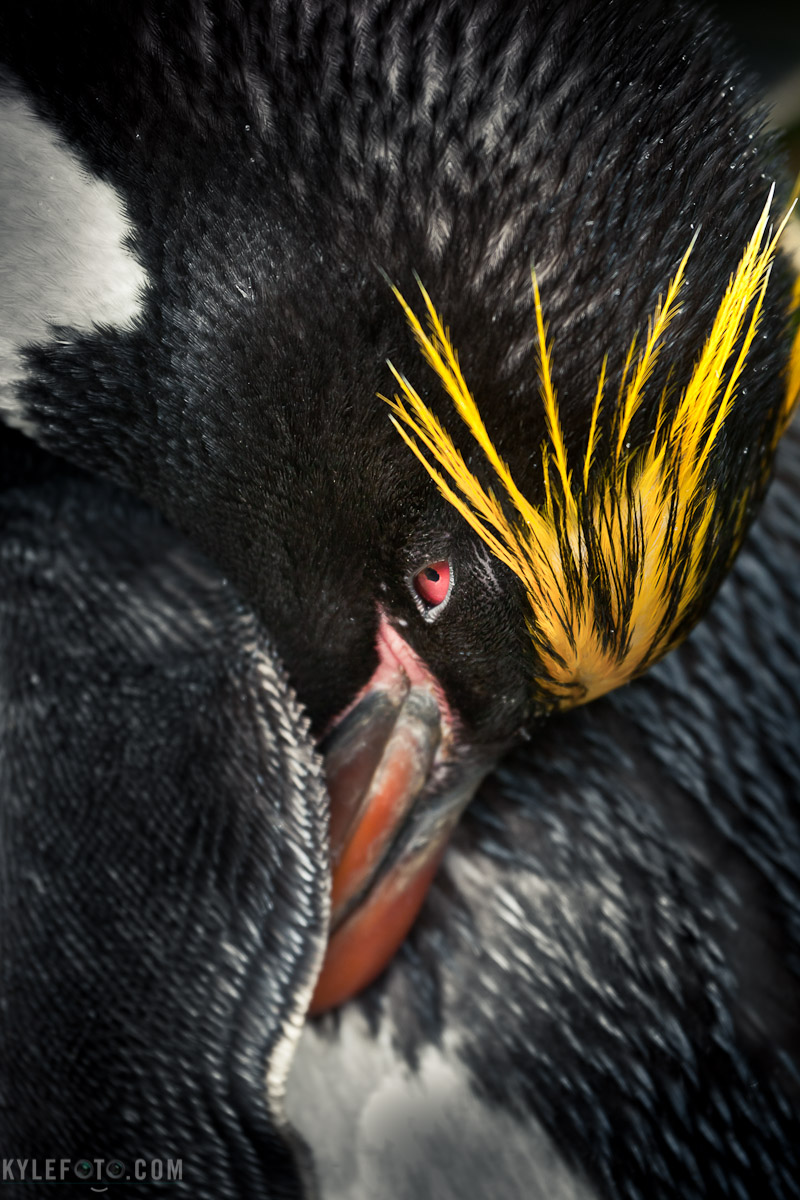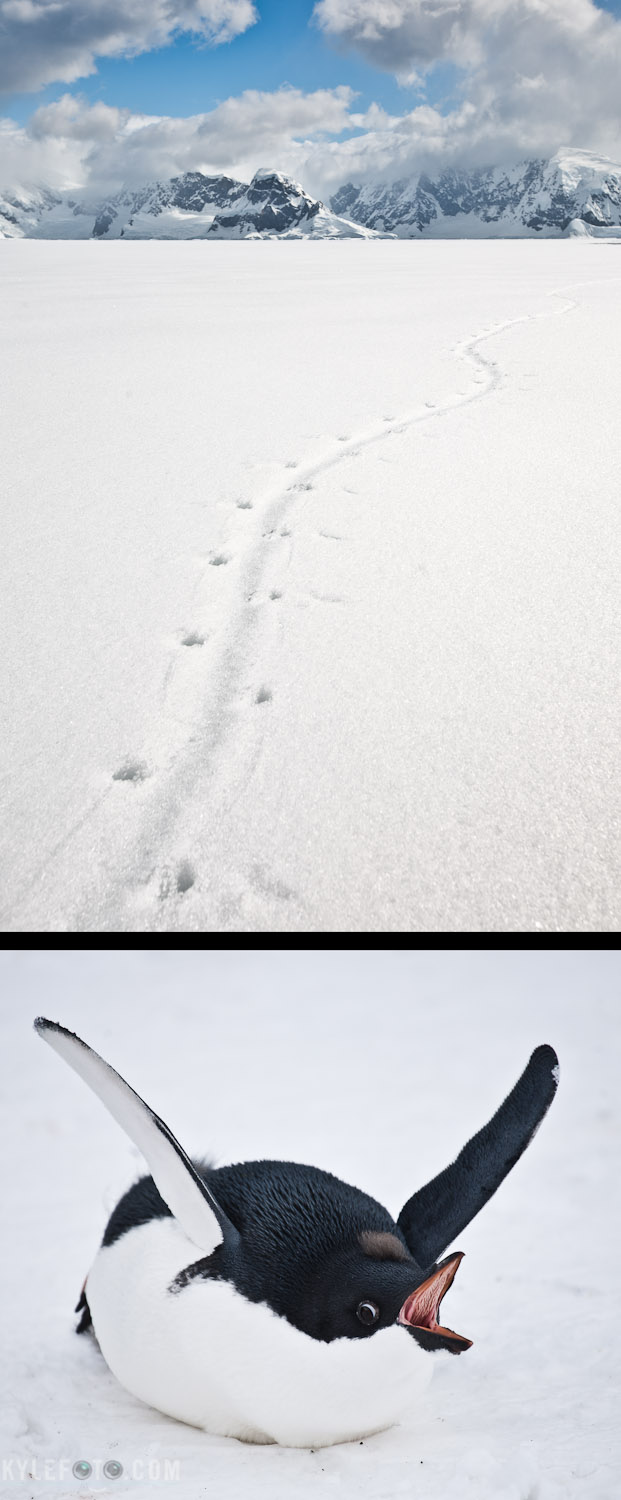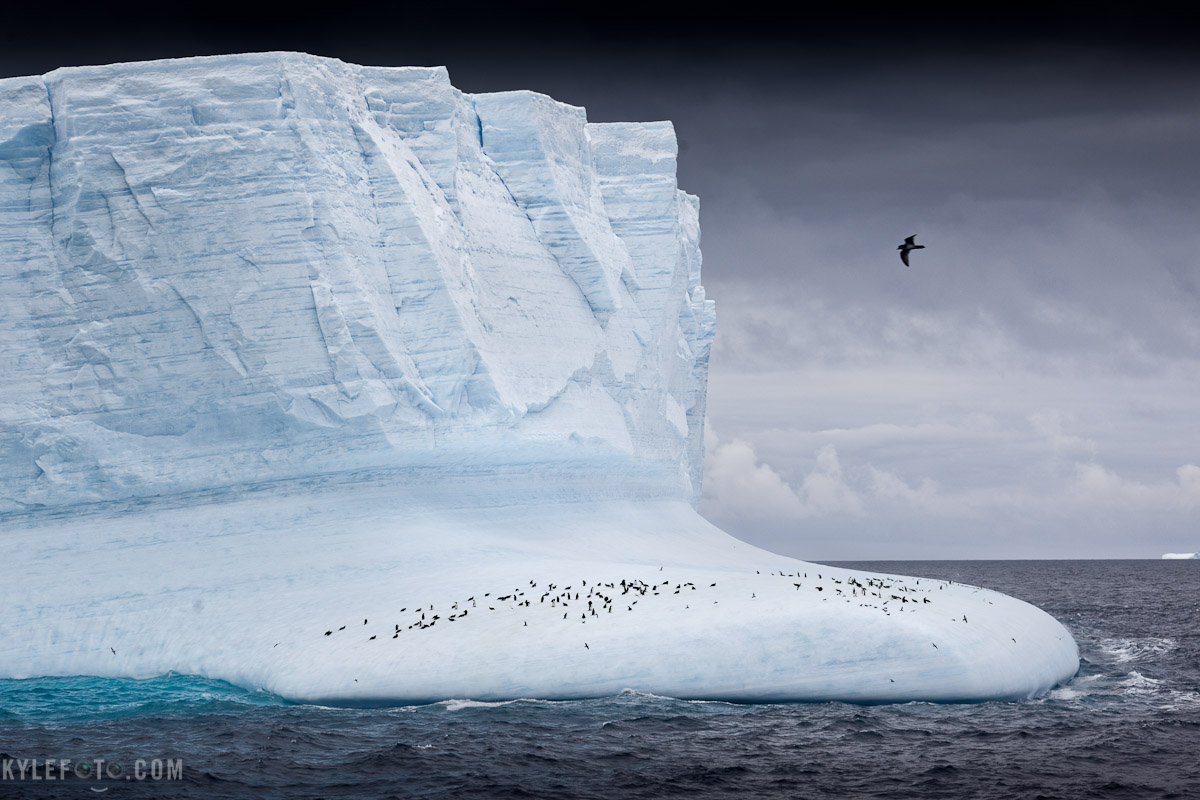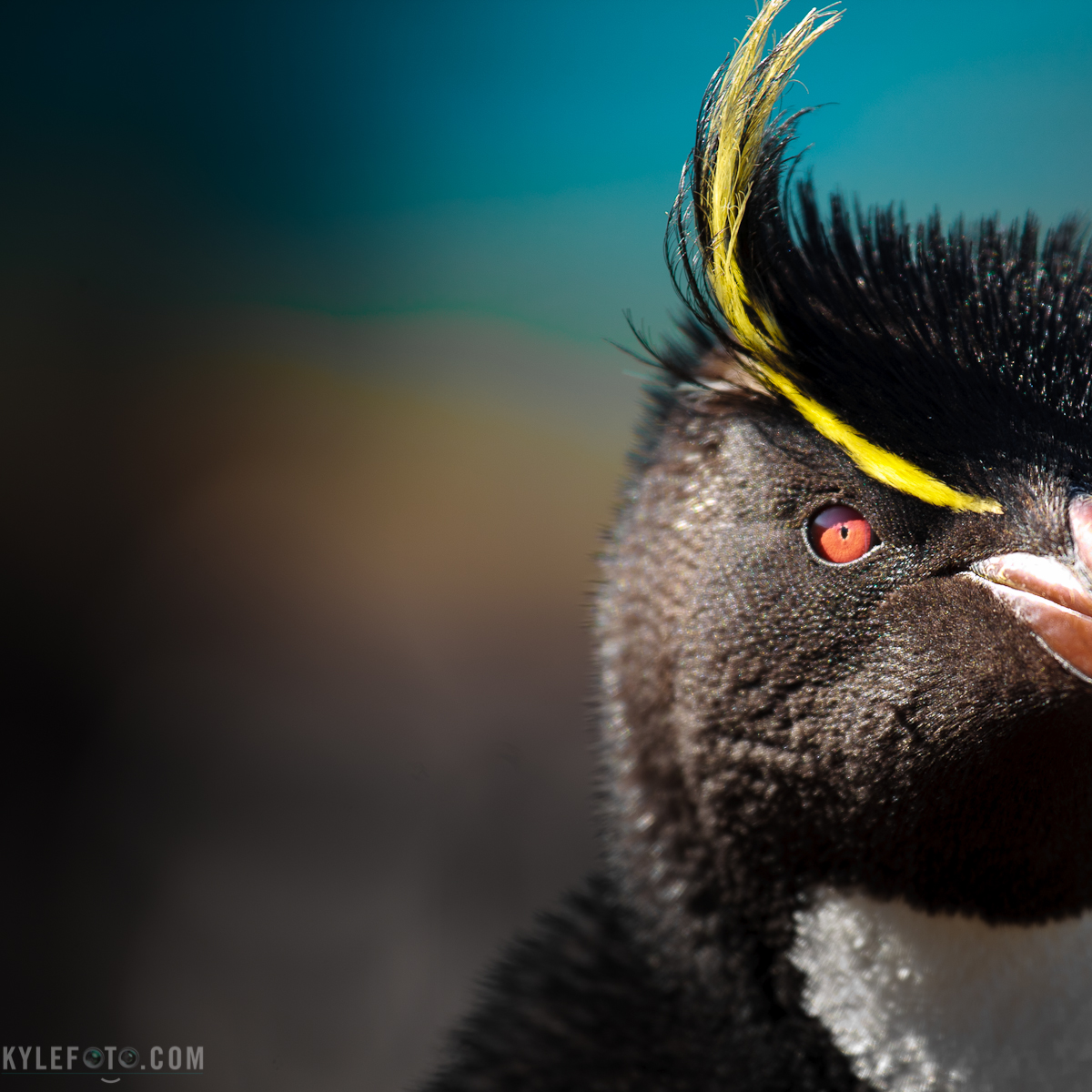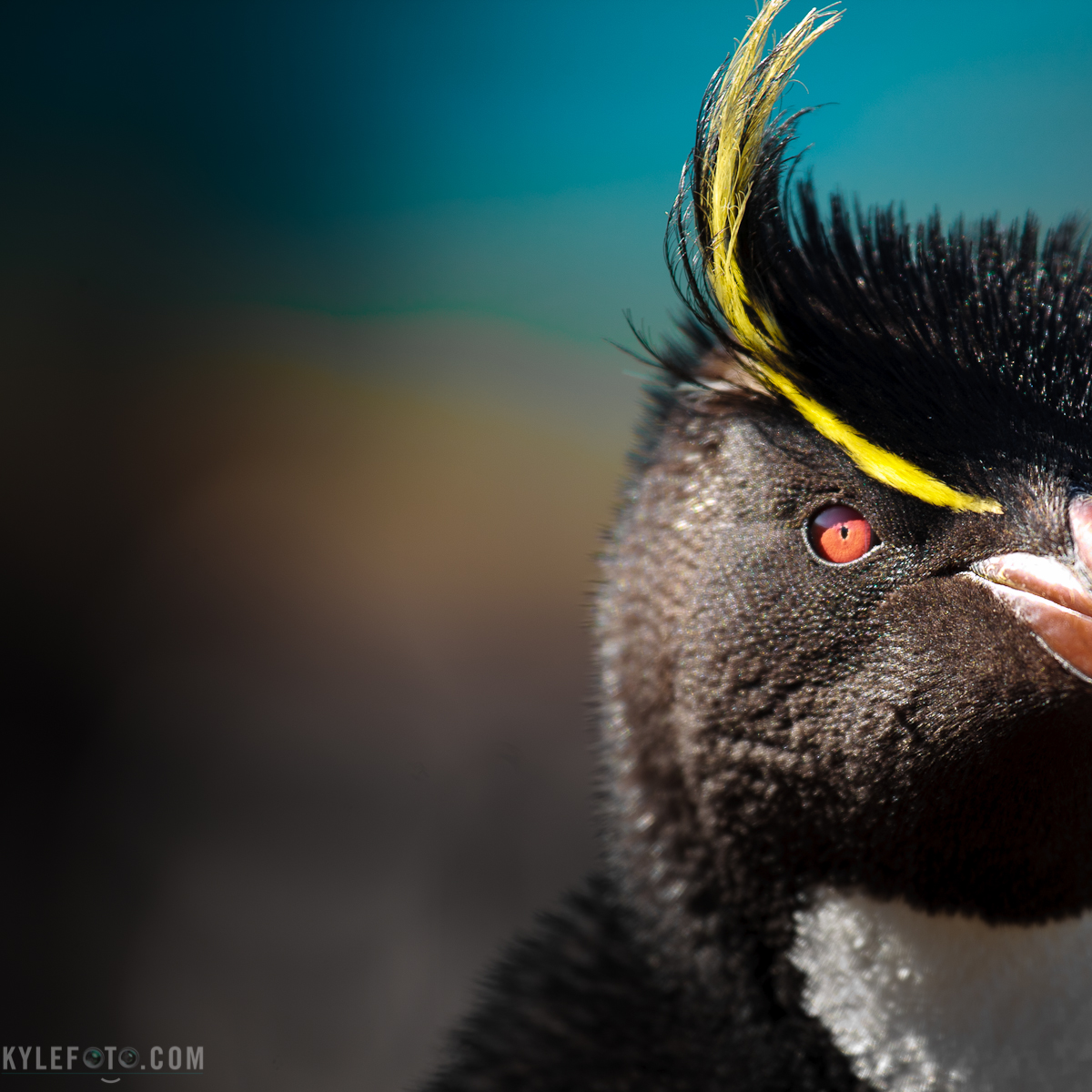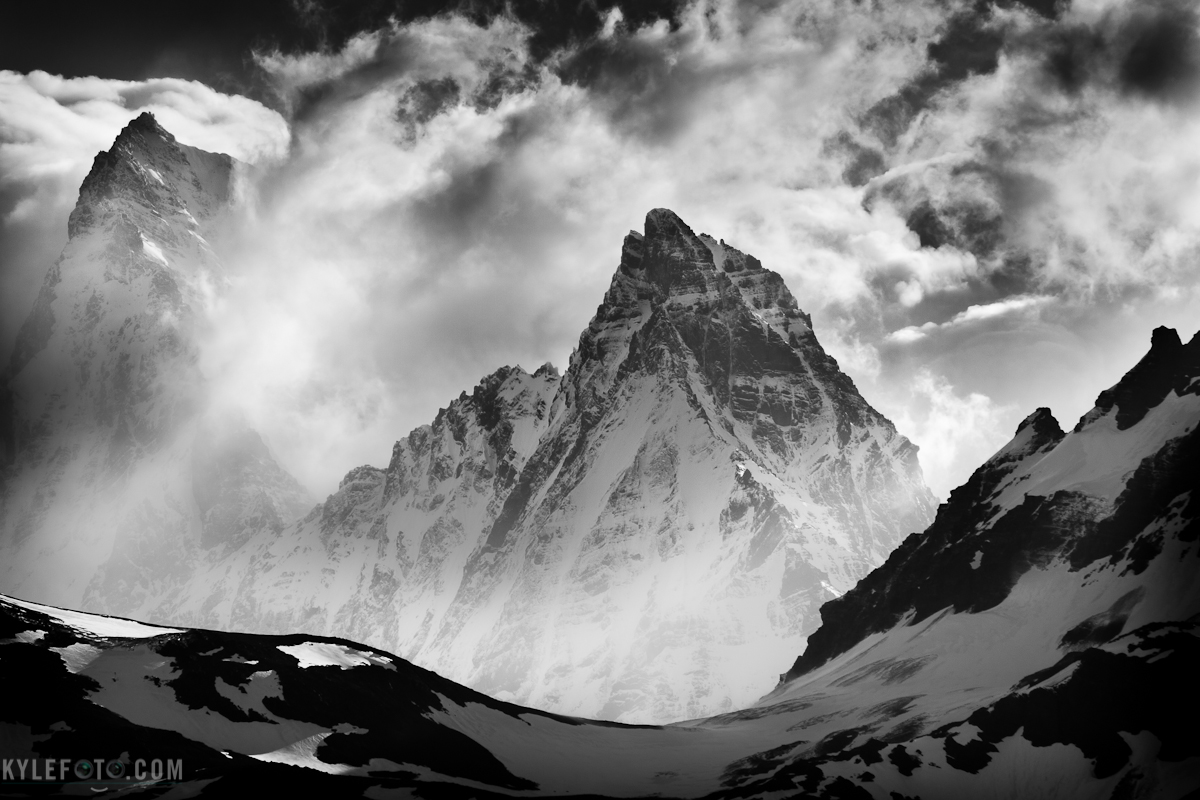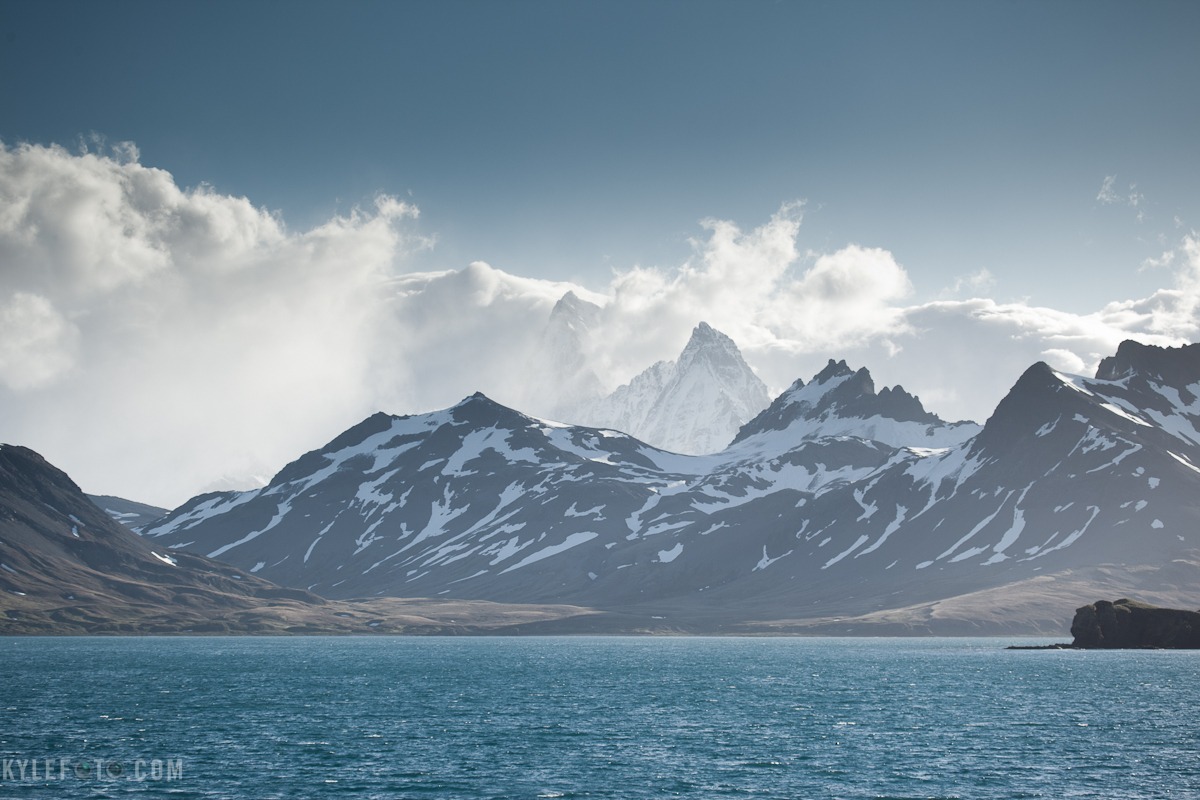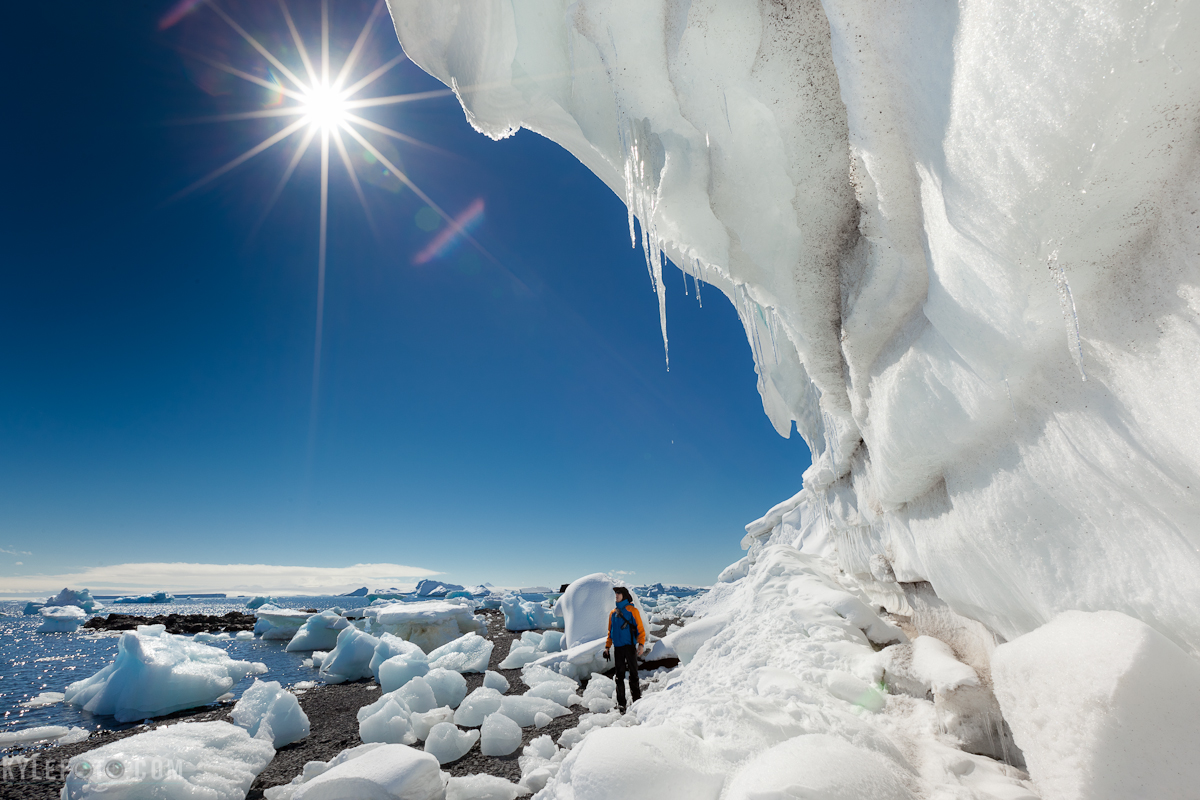Antarctica
Antarctica
Antarctica
Antarctica
Ice and Sky
Antarctica The ice whips off the continental glaciers of antarctica, carrying with these torrential winds a fine dusting of ice crystals. These give the edges of the glacier an etherial feel, looking like a continental sized thermos of liquid nitrogen as condensed air flows from the edges.
Photographic details: A lot of people think it’s wrong to point their camera directly into the sun, I say keep your lens clean and shoot directly into it! The sun was just above the top of the image and the way the light lit the edges of the glacier and fine ice crystals was perfect. If you think something will be difficult to photograph, give it a try, the result may surprise you.
1/125s f/9.0 ISO100 35mm
The Perfect Exposure, Lyubov Orlova
Antarctica The Lyubov Orlova, this ship named after a famous russian star had it’s hey day, but it certainly isn’t now. I had taken many voyages on this bucket of rust and I’ve decided to post about it given it’s intimate history with the Antarctic. It has recently been bought for $275,000 in the hopes that it’s worth more than that in scrap metal.
My first impression venturing on board was doing life boat drills noticing to my horror that the life boats were not covered. Knowing if this ship ever sunk in Antarctic waters during a strong storm I would be floating but I would still be exposed. I remember formulating a plan to jump inside the much more appropriate inflatable covered life rafts with the russian crew where I would certainly be warmer.
Running my hands along the outside of the of the ship was a very textural affair, 30 years of paint caked on the hull seemed to weigh the ship down and crust off with a slight touch. The skin of the hull was sunken in except for where there were reenforcing bulk heads, sticking out like the exposed ribs of a starving horse. I imagined how many bumps and scrapes this ship had to experience to have so many panels dented and bent inwards and had to stop thinking of such things as I listened to the creaks and groans echoing through the ship at night if I wanted any sleep.
Despite her crotchety demeanour, the Lyubov Orlova’s hallways echoed with the sound of joy and laughter. Filled with the gleeful faces of passengers who just saw their first humpback whale surfacing beside an iceberg, giggles of the people in the bar reminiscing over the farts and sneezes of the elephant seals. If the outer decks could speak they would talk of the feeling of awe so many thousands of people felt as they saw their first iceberg and the grand view of antarctica opened up before them. Who knows what this ship has seen, I’m sure if the cabins could speak they might talk of many nights of love an passion.
After Raw Processing
Before Raw processing:
Photographic Details: With this shot I got “the perfect exposure” not so bright that the highlights are overexposed, not too dark that there are no details in the shadows, this is what one would consider a perfect exposure and all without HDR. Yet the original image looks like garbage, it’s flat, has no contrast and the sky looks grey. I was there, and that sky was not grey! That old ship wasn’t bland dark blue it was royal blue and bright orange, and despite it’s age the fresh coat of white paint was stark white.
Thank goodness I shot this one in RAW.
Of course in lightroom I increased the contrast and selectively brightened the ship with the brush tool set to exposure. With about 4 adjustments I’ve gotten a wildly superior image that is far more like being there than the original image expresses.
I was also experimenting with a wide angle fisheye lens, I really loved the extreme distortion but quite frankly it’s a little too much and quite gimmicky. I do like how the distortion leads your eye to the centre of the image, and how it adds a sense of drama, but use this lens too much and you might bore your audience, use sparingly.
See the original shot before processing at www.kylefoto.com to compare!
For #wideanglewednesday curated by +Asif Patel
Diddle Berry
Falkland IslandsFrom the holiday collection http://www.kylefoto.com
This bright red berry found in the Falkland Islands as well as all over Argentina and Chile always brings me a smile. One of the first times I came across this I was actually with my mother who loved the bright red colours. It’s called the Diddle Dee berry or the Red Crowberry and to be honest, I think it’s an acquired taste. I always thought it was funny how my mother skipped the “dee” and simply called it the “Diddle Berry”. Locals here often turn it into jam, most likely for their crumpets.
Photographic Details: Photos like this aren’t usually my style, I often prefer a sharper image with much more detail. But This image has appealed to my mother and many other people once they saw it. Sometimes it’s just about the splash of colour and the memories behind the image. And if people love it, I’m not going to complain!
Canon 5D 1/100s f/2.8 ISO200 100mm
Every photo in my smugmug is now 50% off until Dec 25th with the code: WELOVEWINTER
[button size="large" link="http://kylefoto.smugmug.com/Other/The-Christmas-Collection/20357237_sm3tcH#1610450987_LgJWX2V" linkTarget="_blank" color="blue"]Order Print through Smugmug[/button]
They called him Macaroni... Penguin
South Georgia, Antarctica Macaroni: A term used in the mid 18th century to describe an unusually fashionable man who cared very much about his appearance with a flamboyant flair. Previous terms such as fashion-monger, ninny and fop were also used for someone overly concerned about their clothing. The Macaroni fashion was a precursor to the “dandies” which were the early 19th century metrosexuals.
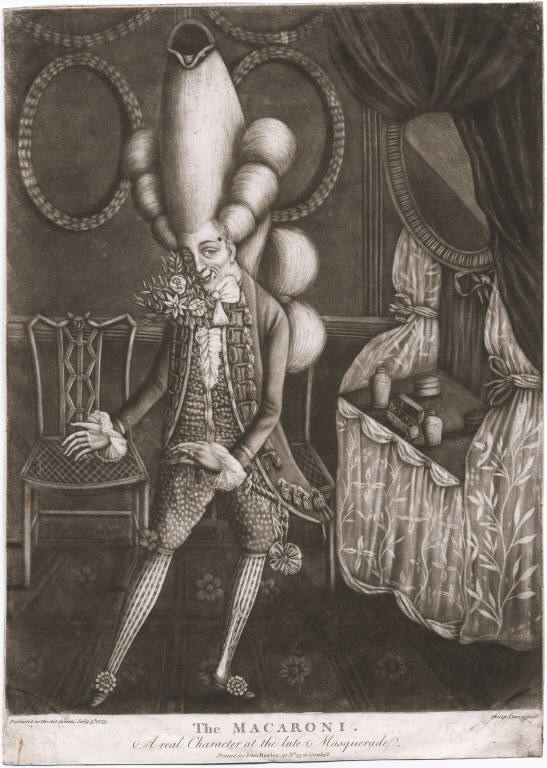
Hence once the unusually vibrant crest of the Macaroni penguin was first observed they were given this name. These penguins were sitting on their nest, carefully keeping an eye on us while they tucked their necks in to conserve warmth and rest. Macaroni penguins lay two eggs during the mating season but often toss the first one out to make way for the second. The mother and father will share their responsibility over the egg as it incubates for a month, and raises the chick over another month. In this time the parents may fast for up to 42 days losing 40% of their body weight. Talk about dedicated parents.
Photographic details: I had to be very careful approaching these penguins. Believe it or not there is tall tussok grass growing here, it’s easy to accidentally step on a macaroni nest in a place like this. As we crouched down to their level this guy would keep an eye on me but that was the greatest reaction this bird would give me, and I respected their space as I waited for them to take a brief glance at me. After spending time with these fastidious penguins, I realize they only live up to their namesake in appearance. Canon 5DMarkII ISO400, 400mm, f7,1 1/320sec
Ghosts of South Georgia
Gold Harbour, South Georgia, Antarctica The edge of the harbour that is home to 25,000 breeding pairs of king penguins. The sea is the key to life here, where penguins can bring krill and fish back to the mouths of their hungry chicks. This place was called “Gold Harbour” by whalers given it is full of large elephant seals and numerous king penguins. They were easy to capture and kill to be boiled for their blubber and oil, which was worth a lot of money in this last haven for whalers. In addition a lot of pyrite or “fools gold” had been found by Filchner’s German Antarctic Expedition in 1911.
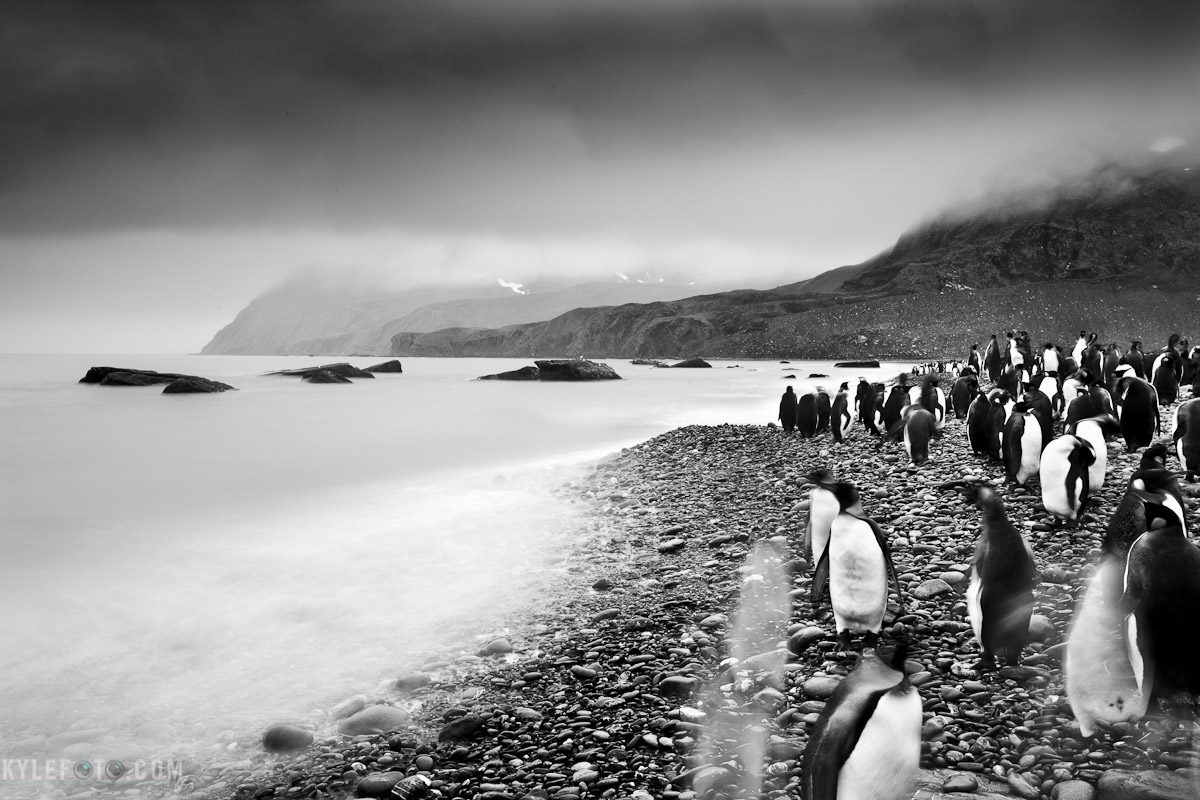
Photographic details: I wanted to create a ghostly image with a lot of mood and drama, the long exposure technique works very well for this. With the extreme brightness of the mid day sun filtering through the overcast sun the longest exposure I could get was four seconds. In order to get the long exposure I wanted I had to mash 20 four second exposure images together to create a total of 80 seconds.
ISO50, f18, with a 5 stop ND filter, 20 4 second exposures combined into 80 seconds If you like this, do me a favour and please share!
Penguin sledding
Wilhelmina Bay, Antarctica, Christmas Day Imagine yourself laying on your belly in the snow with your arms and feet splayed outwards. Using your belly as a sled you paddle your arms and legs to propel yourself forwards, if you do this, you are now a penguin.
Penguins will lay down on their belly and extend their front flippers while gently kicking with their toes, almost like paddling. Their smooth bellies mostly free of friction allow them to slide with relative ease. I have seen them slide down hills with glee, sometimes taking small tumbles but for the most part executing this move with grace. Should the hill be really steep they err on the side of caution and waddle down on their feet.
The tracks left by Adélie penguins made a rather long S shape in the snow, I find it hilarious as they depict exactly how this penguin gingerly sled across the frozen sea ice of Wilhelmina bay.
Moving in this fashion can be very efficient, important for both conserving energy and preventing themselves from overheating as penguins are very well insulated and overheating is a real problem on warm summer days.
Canon EOS 5D, 16-35mm f 2.8L lens, 1/125s f/8.0 ISO50 35mm
If you like this, please do me a favour and share!
Learning to read icebergs
Antarctic Peninsula Look at this iceberg now, then look at it after reading this and you will actually be able to read this iceberg.
There are so many stories in this photo alone I don’t know where to begin. I should start with the fact that a quick glance at an iceberg can tell us a lot about it’s history; mother nature etches a story in every crack, layer, texture and curve.
First of all this iceberg is in mostly in the same orientation it was when it first broke off the glacier it came from. The horizontal lines are the layers of snow that have been compressed into ice while the glacier was flowing down the mountain, as well the surface had an edge of snow, still built up from high precipitation, this tells us the ice is still mostly upright.
Once this huge chunk of ice was set free into the ocean, it began to melt faster than it would as a glacier. The currents and movement of the salty sea water begin eroding the bottom of the iceberg but in a smooth pattern, turning hard edges into soft curves. The “shoreline” on the iceberg is where the lapping of the waves on the surface erode the iceberg the most, creating the indentation in the middle where the smooth ice ends and the rough untouched ice begins.
As the iceberg melts and chunks fall off, the balance changes. As you can see the lower right portion of the iceberg used to be underwater because it’s smooth, it’s now above water with the new weight distribution.
This iceberg is now peppered with Adele penguins. It may be a lot of penguins who are two years old and younger; essentially spinster penguins not yet mature enough to breed. They have no obligation to be in a colony and get to spend the first two years of their life feeding and enjoying themselves. The cape petrel flying on the top right creates a point of interest in the most perfect spot, further illustrating how icebergs can be mother natures “rest stops”.
But there is more! Ice creates a mini ecosystem that krill and small copepods and crustaceans tend to cling to. Small slivers of grey dot the lower left of the iceberg betraying the presence of Antarctic Terns fishing for these small creatures. These waters are rich with life, and as desolate as an image can seem, a trained eye can see an abundance of wonderful creatures.
Take a look at the ice again, do you see what I see?
If you like this, do me a favor please share!
Rainbow whale surprise
Antarctic Ocean Can you guess which species this is? I want to know how many whale watchers there are here, post your answers in the comments! I'll post in the comments later. Hint, it's a species seen often in the Antarctic, and if you've watched whale wars you definitely would have seen them before!
After an uneventful sunset mother nature decided to prove to us she’s always got something hidden up her sleeves. This is where travelling workshops is such an exciting thing. We are winding down for the night, some people have gone to bed, nobody is really expecting anything to happen on a calm evening. But we always have people posted on the bridge, and when something breaks through the waters surface it’s such a thrill to get on the ships loudspeaker and exclaim “There are whales off the starboard bow!”. The calm lull around the ship turns into a feverish buzz as people scramble for their cameras and hurry for the nearest exit to the outer decks.
As the cool evening air washed over me I had never seen such a stimulating canvas of colours painted onto the reflections of the sea. This whale was gingerly swimming around the ship, somewhat curious of what we could be. Talk about a perfect end to an evening.
Photographic Details: It was extremely dim outside given that the sun had already set, so I had to let in as much light as possible with ISO 1600 with a relatively slow shutter speed of 1/400th of a second at f5. This was the best I could do on a moving ship hand held with a telephoto lens. I just kept shooting away while this whale was bobbing in and out of the water.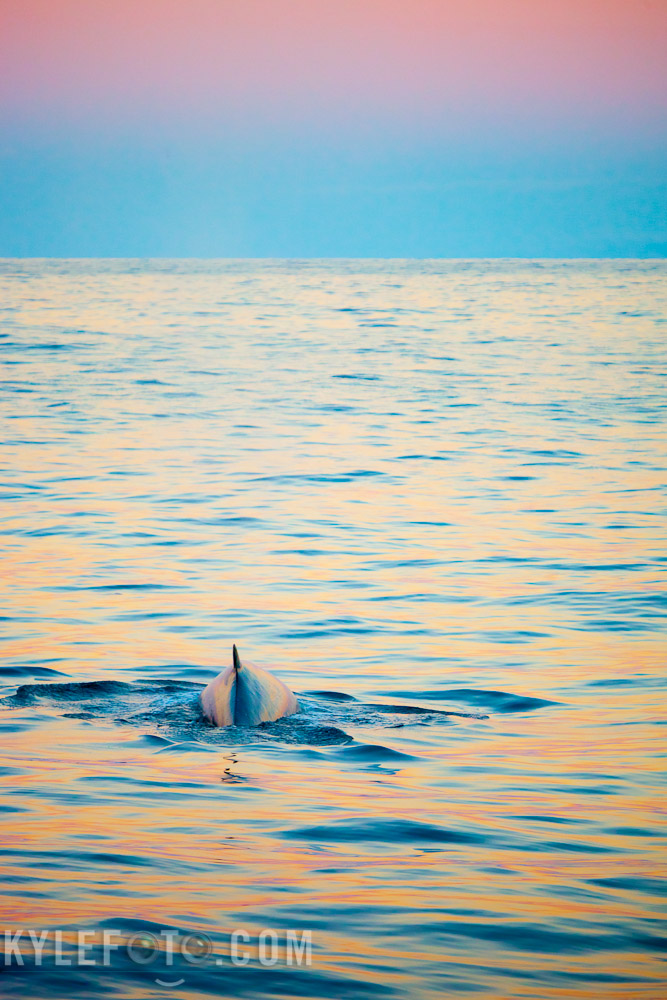
Sometimes photographers talk to the penguins
Falkland Islands, Southern OceanThank goodness it's my favourite day #wildlifewednesday !
These Rockhoppers have a lot of character. Not only do they live up to their namesake by hopping around the beach in the most comical way, they have a bright yellow flourish on their crest and piercing red eyes. The beach is littered with the dark bouncing figures of these guys, the only thing to do is take a seat and watch the show.
Photographic Details: Sitting amongst these guys I enter “spy mode” with my telephoto lens. Waiting for the right penguin to look in the right direction while also facing the sun so I can get those bright red eyes illuminated. These guys are busy so they aren’t all that interested in me, saying “Hey there, nice yellow crest” or “I saw you on the Fleetwood Mac album cover can I have your autograph?” didn’t really work, however screeching like they did got me a head turn and a few looks.
Yes I have learned to call to penguins now. They really don’t care what sound you make, but as soon as you start sounding like them they start paying attention. I look like a complete idiot hunching down taking photos and making penguin noises, but I’ve learned for a long time that if you don’t look like an idiot doing it, you probably don’t have an interesting photo.
I wanted the profile to focus in on the eyes and crest, and since their heads are symmetrical I thought I would take a different approach and get half the face, this makes for a more unique photo than the typical full face penguin portrait.
To see more or get a print see my smugmug here: http://kylefoto.smugmug.com/Antarctica/Antarctic-Worlds/19589737_M4DwLg#1538623730_9pjmrFs
I put a lot of work into my photography if you like this do me a favour and share this with your friends!
Google+: View post on Google+
Shooting landscapes with wildlife lenses
The Spires of South GeorgiaSouth Georgia, Antarctica
After one has gone to South Georgia, it is easy to talk about how dramatic of a place it can be. With seemingly calm weather that can turn hostile in a moment, to the great stories of exploration and survival that haunt the mountain sides, it’s a combination of history, geology and abundant wildlife that contributes to the grand atmosphere it exudes.
Photographic Details: This photo is no exception, with shafts of light piercing the clouds and mist settling in the valley this little scene stood out from the distance but in the grand scheme of things was only a small portion of the overall view. I had to zoom with a big (400mm) lens to get the scene as I saw it. Our eyes and brains are good at filtering out the things we aren’t interested in and instead, focusing in on the things we find attractive. In order to express what I felt photographically I had to zoom in. Traditionally scenery photos like this are taken from up close to the mountains with a wide angle lens, it just goes to show that the type of lens doesn’t necessarily restrict it to the type of photos a photographer can make with it.
The photo processing exactly emulates my film darkroom process. Dodging and burning (darkening and lightening) areas of contrast to bring the areas of detail to light, I pay homage to the days of silver images in my digital darkroom.
If you like the work I put into this, help me out by sharing it!
To see the colour version or get a print see my smugmug here: http://kylefoto.smugmug.com/Antarctica/Antarctic-Worlds/19589737_M4DwLg
In album The Master Collection (64 photos)
Google+: View post on Google+
Post imported by Google+Blog. Created By Daniel Treadwell.
Glacier in the sun
Glacier in the sun Antarctica
It was an ultra windy day, too windy to do any landings to explore other areas. Luckily in the shelter of this ice shelf we were able to get our zodiacs out to explore this bit of area amidst the whipped up ocean. We still had to get out into the weather to get here, after being soaked from the surface of the water being carried by the gale, this little part of the ice shelf felt like a calm piece of heaven. Fine snow was being blasted off the glacier by the katabatic winds, giving the edges an etherial feel. You can see this fine dusting in the sun star, it was like a frozen mist.
Photographic Details: Those who have been following my photography know that I’m not afraid to shoot into the sun, something a lot of people have been taught not to do. And like my other sun shots I used an aperture of f16. This employs more aperture blades, and the more blades used, the more points you see in the sun star. The high image quality of proper RAW exposure and processing ensures that even the shadows have details, all with taking only a single exposure, an important skill to learn while in a moving boat.
For more antarctic photos check out my antarctic worlds gallery: http://www.kylefoto.com/galleries/antarctic-worlds/
The Skua, Lay down for your wildlife shots
The SkuaAn inquisitive animal is an intelligent one Gold harbour, South Georgia, Antarctic island.
The Skua is one of the most visible predators of penguins in the Antarctic, but also the most intelligent. I parent penguin will often chase after a skua to defend it's egg or chick, but unfortunately for the penguin, the Skua will work in teams. While the parent is distracted the other bird will come in, and they will get to feed. A penguin egg or a baby chick is a high reward for a Skua, I know it might be terrible to watch, but the skuas need to eat too (and their chicks are cute!).
Photographic details It was a joy to get a shot like this, it's times like these that carrying two cameras really comes in handy. I was watching the King Penguin colony, ready to shoot close up shots of penguin behaviour with my telephoto when the skua flies in right in front of me. I pulled out my other camera with my wide angle lens (16-35mm f2.8) and managed to get a few of these shots while the Skua pecked at my polariser. [lightbox id="2" size="small"] While this happened by accident, I maximised my chances of interacting with wildlife by laying down flat on the ground. In this position not only do I have the best viewpoint, I'm also not considered a threat and more of a curiosity to wildlife. Laying down I have had elephant seals snuggle me, penguins walk on me and of course, skuas investigating my lens. I also chose to keep a lot of the background and penguin colony in this shot, keeping this bird in full context of it's environment.
This is a blog post originally posted on http://www.kylefoto.com, If you like this be sure to check out the Antarctic Worlds gallery!
Put people in your landscapes
Put people in your landscapes Too often photographers go to great lengths to ensure there are no people in their photographs. This is often something difficult to do especially when on holidays and in touristy places.
Why not get the people to work with the landscape? How can adding a person or two improve a photograph? One of the most helpful things a human figure can do in a photograph is create a sense of scale
I was trudging along the shoreline in Antarctica, scattered with beached pieces of ice berg left by the waves and tides when I came upon this lovely scene. It was missing something, and I was alone, so I decided this was a good job for the 10 second timer on my camera. I stuffed my tripod into the snow, ran into the landscape as far as I could, and did my best to “look into the scene” in time for the shutter to release. Running back and forth was actually pretty good exercise, and pretty fun! I encourage you to try this environmental self portrait in your next sunset or interesting landscape shot, I’d love to see them if you do!
Technical facts: It’s important to note, on my particular lens (Canon 16-35 f2.8 L) and many other lenses, that when I stop down to f/16 I get a beautiful star shape out of bright objects like the sun. The number of aperture blades employed in the lens determines how many points you see in the star, even more reason to go with the “sunny f/16 “ rule!
Share if you like!
This is a blog post originally posted on http://www.kylefoto.com, if you like this be sure to check out the Antarctic Worlds Gallery here!
Porcelain Adélie
One sunny antarctic day was standing on a rock at the entrance to a penguin colony in Antarctica, watching them zip around underwater with joy. One of the coolest things is that they tend to jet out of the water onto land, but I don't think they look before they leap. Every so often one would fly out onto my rock only to be extremely surprised to see me standing there, immediately and frantically trying to back-flap their way into the water. This Adélie was particularly entertaining!

Luminous ice
This beautiful iceberg was grounded by the low tides in Antarctica outside Cuverville island. The water being so crystal clear and free of sediment that light travels down without reflecting much back making it appear black. In addition the bright overcast conditions and high reflectivity of the snow and ice forces me to let in less light in the camera, darkening the water down even more. It's this contrast that gives the image a sense of drama.
Lately I have been very active on Google+ and have found the community to be very engaging, for that reason I have been premiering a lot of my content on my page here first. So I feel compelled to post some extra info derived from conversations on this article as well.
Thomas Russ Arnestad asks: "I'm curious about one thing though, there are some grey/black spots/shaded in the blue ice; is this a result of pollution?"
I was very careful to keep those spots in there, as they aren't artificial (nor are they dust spots on the sensor). I'm delighted you noticed them because they tell a fantastic story about the formation of these icebergs. I think it's safe to say these icebergs are pretty much geological in origin, as all icebergs start off as glacial ice formed by the compaction of snow on the mountain slope. This ice slowly flows down the mountain, and in doing so it grinds away at the rock, creating gravel and silt and carving U shaped valleys in the mountain side. When some of these pieces of ice finally make it into the ocean, they may have picked up lots of debris and rocks, some can be extremely dirty, huge boulders can even be found in icebergs. You can even go diving in the antarctic and find large "erratics" deposited by rock carrying icebergs.
The older the ice, the more likely it is to be at the bottom of a glacier where there is an extreme amount of pressure, this pushes out air bubbles and causes the ice to become more translucent, and this in turn can make the ice bluer, hence the wonderful colours in this ice and the high amounts debris trapped inside.
Technical photo details: This was shot hand held while driving a zodiac (like the image atop) , then tonemapped in HDR software Photomatix. Later printed on metallic paper the colours really shine and shift, much like the ice does in real life! Approximate location here.




